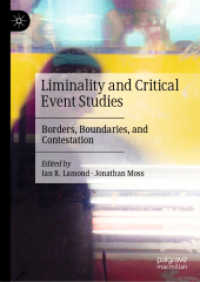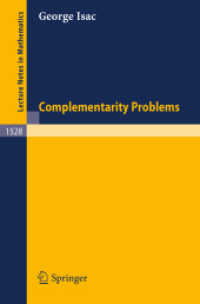Full Description
Regions of the world with greatest biodiversity are shown to exhibit greatest linguistic diversity, strongly suggesting that the relationship between language and ecology is both symbiotic and spatially and temporally determined. This volume examines the expressions of, and threats and challenges to, this relationship in southern and eastern Arabia.
Exploring the ways in which indigenous languages reflect the close relationship between people and their natural environment, this book presents an overview of the key threats and challenges, and introduces the methodologies used to investigate them. Across the chapters, case studies are presented dealing with language, gesture and ecology, the significance of naming, the role of narratives in the language-ecology relationship, and conservation and revitalisation of bio-cultural diversity in Arabia. Taking a multidisciplinary view, this book argues for the central role that language plays in facing the challenges and threats to bio-cultural diversity, and presents methods for the study of the language-nature relationship that can be applied globally.
Contents
List of Figures
List of Maps
List of Tables
List of Contributors
Acknowledgments
Introduction, Janet C.E. Watson (University of Leeds, UK), Jon Lovett (University of Leeds, UK) and Roberta Morano (University of Leeds, UK)
1. Language, Gesture and Ecology in Modern South Arabian Languages, Jack Wilson (University of Salford, UK), Janet C.E. Watson (University of Leeds, UK), Andrea Boom (University of Leeds, UK) and Saeed al-Qumairi (Hadhramawt University, Yemen)
Part I. Arabia: The Significance of Names
2. What's in a Name? Miranda Morris (Independent Researcher)
3. When Water Shapes Words: Musandam's Kumzari People and the Language of the Sea, Erik Anonby (Carleton University, Canada), AbdulQader Qasim Ali Al Kamzari (Sultanate of Oman) and Yousuf Ali Mohammed Al Kamzari (Ministry of Health, Oman)
4. Water and Culture Among the Modern South Arabian-Speaking People, Fabio Gasparini (Freie Universität Berlin, Germany) and Saeed al Mahri (Independent Researcher)
5. A Botanical and Etymological Approach to Plant Names in Southern Arabia, Shahina A. Ghazanfar (Kew Gardens, UK) and Leonid Kogan (National Research University, Russia)
6. Traditional Knowledge and Vocabulary around Weather and Astronomy in Qatar, Kaltham Al Ghanim (Qatar University, Qatar)
7. Plant and Animal Terms in ?a?rami Arabic Idiomatic Expressions, Proverbs, and Chants, Abdullah H. Al Saqqaf (Independent Researcher)
Part II. Arabia: Narratives and Ecology
8. The Language of Kumzari Folklore, Christina van der Wal Anonby (Carleton University, Canada)
9. Orature and Nature in Southern Arabia, Sam Liebhaber (Middlebury College, USA), Kamela al-Barami (University Leeds, UK), and Ahmed al-Mashikhi (Sultan Qaboos University, Oman)
10. Climatic Disasters and Stories of Resilience in Southern and Northern Oman, Suad Al-Manji (Ministry of Education, Oman) and Janet C.E. Watson (University of Leeds, UK)
Part III. Arabia: Conservation and Revitalisation
11. People's (Non-)Participation in Conservation: A Case from Oman, Dawn Chatty (University of Oxford, UK)
Conclusion
Index







